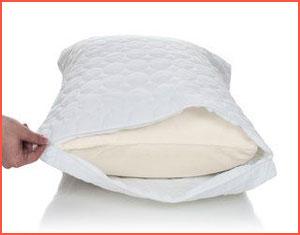
Our best pillow protector reviews provide you with information on our top 5 pillow protectors. We have paid specific attention to protection against bed bugs (yes, they can infest your pillows), allergies and how waterproof they are. Comfort is also an important factor.
First: why do you need a pillow protector? There are several possible answers, for example:
- To keep your pillow clean from mascara, lipstick, face powders, rouge (or is that an old-fashioned term for blusher?) and other cosmetics.
- Whether you like to know this or not is immaterial: Most people drool at some time while they are sleeping. Not every night, but perhaps after a hard night on the town, or if you tend to sleep with your mouth open - as many do! Toddlers often do this as well.
- Your natural body oils can also contaminate your pillow - nose oil is a common factor here.
- Shed skin cells: your body sheds around 250,000+ skin cells while you sleep. Part of that is shed from your head, face, and neck.
- It is said that 10% of the weight of a 2-year old pillow can consist of dust mites and their droppings.
** Dust mite feces contain a substance known as DerP1 which is a powerful allergen. If you are allergic to this then you can develop eczema, sinus problems or even breathing difficulties.
Here are our top 5 pillow protectors that can help prevent the above issues. We will follow that with a Buyer's Guide, providing you with information on what you should be looking for in a good pillow protector.
NOTE: We are using the Queen size for our reviews. Some are available singly and others in packs of two. So you should check carefully if you need a pair: some come in pairs, though often you have to purchase two pillow protectors.
Important: Pillows can be described as standard size, king size, queen size (as the ones we are reviewing here) and other sizes. These descriptions can vary in dimensions between manufacturers which is why we provide the dimensions in our table above. For consistency, we are using the Queen size pillow protectors in all our reviews.
Pillow Protector Reviews Table of Contents
1. Mission: Allergy Microfiber Premium Pillow Encasing Review
The' Mission: Allergy' pillow encasings have been designed by a Board-Certified allergist, and are recommended by leading allergy specialists. It claims to provide a 100% barrier to dust mites and animal dander allergens.
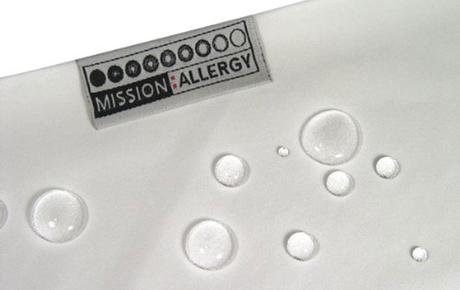
It has a lot more pros than cons:
Editor's Note: Looks superb and of high quality. It may be a bit more expensive than others, but the vast majority of users appear to love this product. It does not allow allergens in, and any that are already in there cannot get out. Its silky finish stops allergens from accumulating on the surface. The seams and edges are bound with seam binding all round for maximum durability. It comes with high quality zippers - and with a 100% lifetime guarantee that any issues will be resolved quickly.
Purchase This Product on Amazon2. AllerZip Pillow Covers - Block Bed Bugs, Dust Mites, Allergens & Waterproof
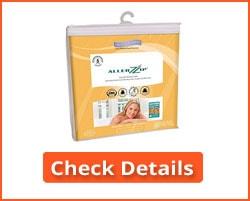
The Allerzip pillow cover is offered by Protect-A-Bed and is available in packs of two. It is made from 100% polyester backed with a membrane barrier (named the Miracle Membrane) that blocks fluids such as perspiration, saliva, spills, accidents, and others from reaching the pillow itself. It also blocks skin cells, pet dander, dust mites, bed bugs, molds, and mildew. Not only that, but any of these allergens already in your pillow will be kept there - and not reach you.
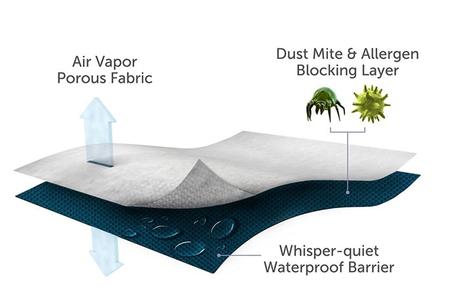
The membrane allows the passage of air to keep you cool and dry. The three-sided zipper is patented and secure against bed bugs and dust mites. The Allerzip pillow cover is also certified allergy and asthma friendly.
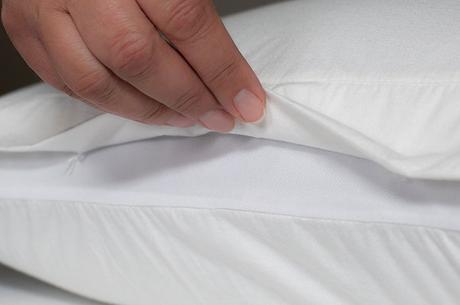
Editor's Note: This appears to be a high quality pillow protector. It not only protects your pillow from dusts and spillages, but also from parasites such as bed bugs and dust mites. Its silky polyester finish makes it easy to clean over with a light brushing, and also provides a smooth sleeping surface for those with dry skin or conditions such as eczema.
Purchase This Product on Amazon3. Everlasting Comfort 100% Waterproof Pillow Protector
The Everlasting Comfort pillow protector claims to be waterproof rather than water-repellant. It is made from cotton terry cloth and contains a hypoallergenic breathable membrane that claims to allow air in and out, but keeps water out.

This is technically possible and keeps pillow feathers in and skin cells, dust mites and bed bugs out! It seems ideal, and most of the reviews online appear to support this.
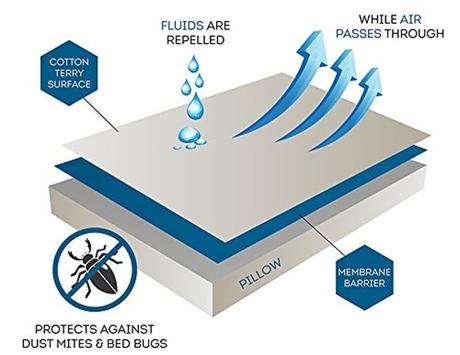
Editor's Note: One of the negatives about this pillow protector is that you have to air dry it. This seems to be a small price to pay for what appears to be a high quality waterproof pillow protector. The degree of waterproofing seems to be questionable since some have complained that it is not resistant to urination: one by a child and one by a puppy! For health reasons, it is not recommended that puppies be allowed to use a pillow as a toilet. Otherwise, it appears to be an excellent buy and is sold in sets of two.
Purchase This Product on Amazon4. Allersoft Queen 100-Percent Cotton Dust Mite & Allergy Control Pillow Protectors
Allersoft pillow protectors are manufactured in the USA using breathable 100% cotton. The cotton is tight woven to prevent skin cells and dust mites getting through to the pillow. It is an excellent buy with excellent reviews. The tight weave not only keeps dust cells out (and so dust mites) but also pet dander which also promotes dust mites and bed bugs.
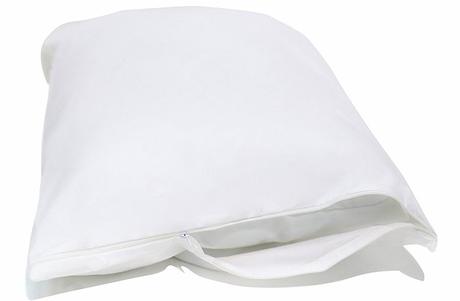
These bugs cannot get through the tight weave of the pillow protector.
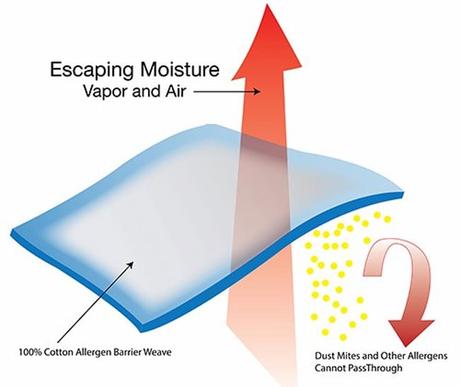
Editor's Note: Please note that these pillow protectors are sold singly. Unless stated, they are singles not packs of two. That said, this product is among the best of all the pillow protectors we have reviewed. Our reviews are compiled from many different sources: user comments, manufacturer websites, online vendor comments and other online review sites. The Allersoft pillow protector is one of the best we have come across.
Purchase This Product on Amazon5. SureGuard Pillow Protectors - 100% Waterproof
The Sureguard pillow protectors come in a set of two. They are 100% waterproof, protecting against saliva, perspiration and various type of liquids: spillages and accidents. It is bed bug proof and blocks dust mites, bacteria, allergens, mildew, and molds.
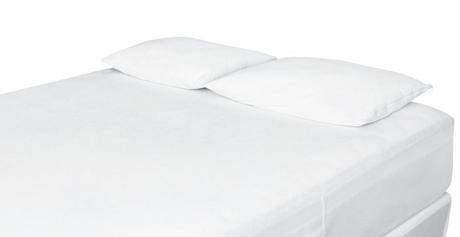
The zipper is super fine to prevent the above from getting in through the zip.
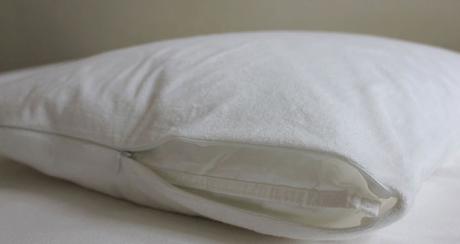
Editor's Note: This is another excellent hypoallergenic waterproof pillow protector or encasing. Many people, however, may prefer the silky finish of polyester or smooth cotton to the terry cotton finish. That is why it is in position #5 rather than higher. That said, its GREENGUARD Gold certification indicates that it is suitable for use by those susceptible to volatile organic chemical emissions (VOCs) and those who tend to be badly affected by them.
Purchase This Product on AmazonPillow Protector Buyer's Guide
A pillow protector, pillow encasing or encasement, and pillow cover are all names for the same item: an all-round protective cover for your pillow. Some also refer to it as a 'pillow slip' or 'pillowcase.' It is used to protect your pillow from contamination by allergens (dust mites, molds, pollen and other dust that can activate an allergy), skin cells, bed bugs, bacteria, moisture and often liquid spillages or body fluids. Once these get into the filling of your pillow they are next to impossible to remove.
What you should be looking for are pillow protectors that keep out bed bugs, dust mites, skin cells and smaller liquid contamination such as sweat, saliva or drool, and minor spillages. The higher quality pillow covers may also be waterproof, and keep your pillow free from larger liquid contamination such as drinks spillages and even your pets urinating on it.
It is certainly not hygienic to allow pets on your bed, and certainly not on your pillow. Although many pillow protectors claim to be waterproof, not all are. Those waterproof pillow encasings we have included in this review are the best of those that claim to be waterproof. However, even the best pillow encasements would be liable to fail in the event of major liquid contamination.
So what to look for? Here are some of the factors you should consider when purchasing a pillow protector.
Material and Thread Count
Most listings for pillow protectors will state the fabric used, but not the thread count. The best you often get is something like ' High thread count' meaning that the threads are thinner, so there is a large number of threads per square inch or square centimeter. The higher the thread count, the tighter the threads are pressed together, so the more difficult it is for bed bugs, dust mites and other types of allergens to get through the cover to the pillow.
Cotton: Cotton is a common fabric, and the higher the thread count the sleeker it feels. Polyester can also feel sleek, and be woven with very small threads. The sleekness not only suggests tighter weaving but also that the surface is more easily cleaned of dust and other contaminants simply by brushing it or even just shaking it. That means you will have less contact with your shed skin cells and associated dust mites than if your cover was rougher.
Terry Cotton: Terry cotton is another form of cotton that is commonly used in pillow protectors. It provides a rougher finish than regular cotton or polyester (below). Some claim that it 'wicks' away moisture - but wicks it to where? A terry top with a moisture barrier below it may resolve this issue - as explained later. Some people don't like the relative roughness of terry cotton compared to the standard weave, while others find it more comfortable.
Polyester: Polyester is another common fabric used for pillow covers. That is because it is synthetic, so often less expensive than cotton, and can also be woven very tightly to prevent the ingress of moisture and allergens. Polyester can also be shaken to remove skin cells and other solid contaminants. Polyester can also provide a sleek, smooth sleeping surface for people suffering certain skin issues. Many people prefer polyester because of this.
Waterproofing and Membranes
'Waterproof' pillow covers are not always completely waterproof although they do resist water to an extent. Others appear to be waterproof in the true sense of the word. It is not the purpose of this pillow protector buyer's guide to explain the science behind membrane layers. Let's just say that they keep water out to a lesser or greater extent according to the quality and design of the membrane.
The membrane lies on the bottom surface of the pillow encasement or cover. Any liquid that gets through the weave of the material meets the membrane which prevents it getting any further. So while your pillow cover still feels wet, the moisture doesn't penetrate into the foam or down filling. That's what's important.
You can easily dry the pillow encasement, and even slight dampness the cover on the pillow itself, but you cannot easily dry the feathers, down or foam that comprises the filling of the pillow. Never expect 100% 'waterproofness'. If you had that, then your pillow would never be able to breathe and any air in it would not be able to escape - it might be like sleeping on a balloon!
Allergens and Other Nasties!
If you suffer from allergies, then you should be more interested in how well your pillow protector does just that: protects your pillow from these allergens. Sure, allergens right on the surface of the pillow cover will affect you. However, if you choose the right material - close woven cotton or polyester - you should find it easy to remove most allergens and shed skin cells from its surface by beating it, shaking it or even vacuuming it regularly.
That's keeping them out - what about keeping them in? The same applies. Your pillow itself could be filled with allergens before you even begin using the protector. But don't worry! Any pillow protector designed to keep allergens, skin cells, pet dander, bed bugs or dust mites getting onto your pillow will also prevent any in there already from getting out and attacking you! In other words, a pillow protector is also a person protector - it protects you from nasties already in your pillow, and from the same nasties getting in there.
Pillow Protector Buyer's Guide Conclusion
So to put it in a nutshell, when you are buying a pillow cover, protector, encasing or encasement (all the same thing), you should have five specific properties in mind:
- Does it prevent skin cells, dust mites, other allergens and bed bugs from passing into the body of your pillow?
- Does it prevent liquids (saliva, sweat, other body fluids, drinks spillages, etc) from passing through the protector into the pillow?
- Is it easy to brush away any dead skin cells or stray dust mites off the surface?
- Is it comfortable to sleep on - no point in buying it if it is not!
- Is it easily washed and dried: machine washing and drying is ideal. Hang drying on an inside or outside line is good if you have the facility to do that - even in winter or when it's raining outside.
A pillow protector does not kill dust mites and bed bugs - or anything else! What it does do is to prevent your skin cells and these creatures from getting into the pillow itself. If that happened (and you may never know) then the pillow protector will also stop them getting out - so they cannot harm you! It's simple really: keep them in or keep them out. Regular cleaning of your pillow cover will help you achieve that.
Frequently Asked Questions
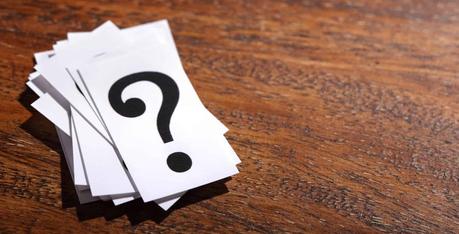
Here is a selection of the questions we have been asked about pillow protectors.
Best Pillow Protector Reviews: Summary
Our selection of pillow protectors was based upon personal experience, reviewable data and on a careful examination of manufacturers' websites. Pillow protectors can ensure that your pillows remain fresh and clean. They can eliminate contamination with accidental liquid spillages, saliva while sleeping, face cosmetics, and many other forms of contamination.
Summary
